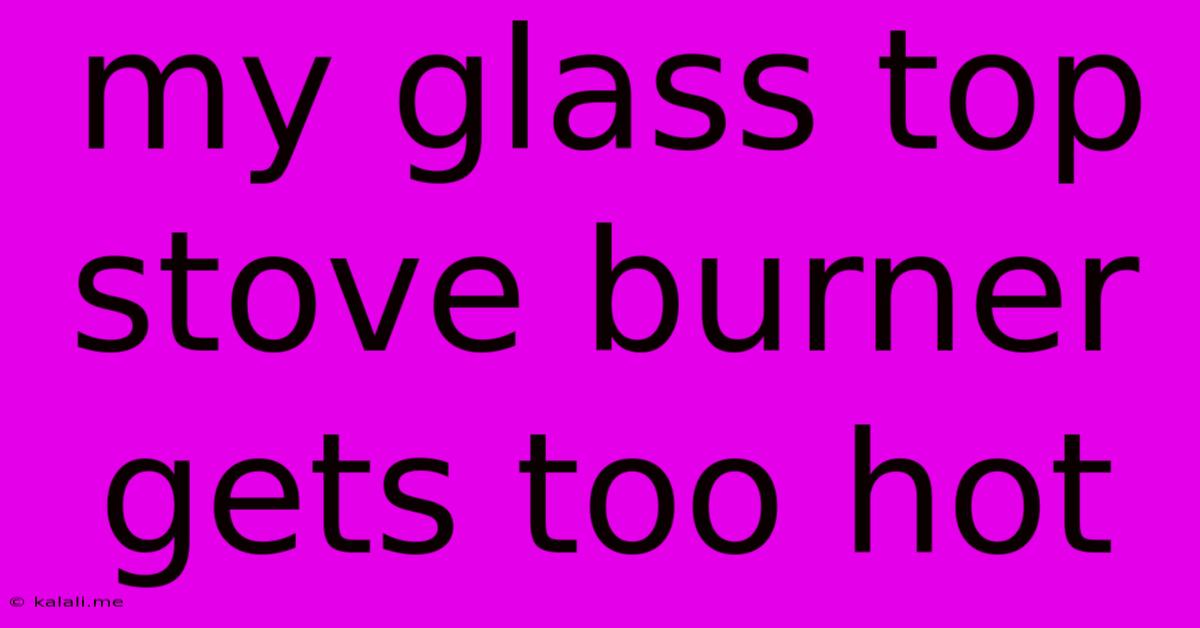My Glass Top Stove Burner Gets Too Hot
Kalali
May 23, 2025 · 3 min read

Table of Contents
My Glass Top Stove Burner Gets Too Hot: Troubleshooting & Safety Tips
Is your glass top stove burner getting excessively hot? This is a common problem that can be frustrating and even dangerous. This article will guide you through troubleshooting common causes and offer practical solutions to keep your cooking surface safe and functional. We'll explore potential issues ranging from simple user errors to more complex appliance malfunctions, helping you determine the best course of action.
Understanding the Problem: Why is My Glass Top Stove Burner So Hot?
Excessive heat on a glass top stove burner can stem from several factors. It’s crucial to understand these to effectively address the issue and prevent potential damage to your stove or even injury. This often manifests as:
- Burner getting hotter than usual, even on low settings.
- Excessive heat radiating from the burner to the surrounding glass.
- Delayed cooling after turning off the burner.
- Visible discoloration or damage to the glass top.
Common Causes and Solutions:
Here's a breakdown of the most frequent reasons for overly hot glass top stove burners and how to fix them:
1. Incorrect Pan Size and Type:
- Problem: Using a pan that's too small or not designed for induction cooking (if you have an induction stove) can lead to concentrated heat and overheating. Some pans may also be prone to uneven heating distribution.
- Solution: Ensure your cookware is appropriately sized for the burner element. The base of the pan should completely cover the burner element. Choose cookware made of materials that are compatible with your stove type, such as stainless steel, cast iron, or enamel-coated cast iron. Avoid using aluminum or copper pans on induction stoves unless they have a magnetic base.
2. Faulty Burner Element:
- Problem: A malfunctioning burner element might produce excessive heat, even at low settings. This could be due to a short circuit or a failing heating coil.
- Solution: This issue usually requires professional repair. Attempting DIY repairs on burner elements can be dangerous, so it's best to contact a qualified appliance technician.
3. Sensor Problems:
- Problem: The temperature sensor beneath the glass top might be faulty. This sensor regulates the heat output and if it's malfunctioning, it might lead to overheating.
- Solution: As with faulty burner elements, sensor issues generally need professional assessment and repair.
4. Build-up of Debris Underneath the Cooktop:
- Problem: Food spills or debris accumulating under the glass top can impede heat dissipation, resulting in increased surface temperatures.
- Solution: Regularly clean your stovetop to remove any debris or food residue. Refer to your stove's manual for proper cleaning instructions. Avoid using abrasive cleaners that could scratch the glass surface.
5. Control Panel Malfunction:
- Problem: A problem within the stove's control panel could result in the burner receiving incorrect heat level signals.
- Solution: Contact a qualified appliance repair technician to diagnose and fix any control panel issues.
6. Faulty Wiring or Connections:
- Problem: Loose or damaged wiring connected to the burner element can cause inconsistent heat output and overheating.
- Solution: This is another situation where professional intervention is necessary.
Safety Precautions:
- Never touch the burner while it's hot: Always allow ample time for the burner to cool down before cleaning or touching it.
- Use appropriate cookware: Ensure your pans are properly sized and compatible with your stove type.
- Avoid overloading the stovetop: Don't overcrowd the cooking area, as this can lead to uneven heat distribution and overheating.
- Regularly clean your stovetop: Keep your stovetop free of debris to ensure efficient heat dissipation.
- Contact a professional for repairs: Never attempt to repair your stove yourself unless you are a qualified technician. Electrical components can be hazardous.
By following these troubleshooting steps and safety precautions, you can address the problem of your excessively hot glass top stove burner and prevent potential issues in the future. Remember, your safety is paramount; if you're uncertain about any repair, contact a qualified appliance technician.
Latest Posts
Latest Posts
-
Doneness Stage Meaning Firm To The Bite
May 24, 2025
-
How To Get Mold Out Of Carpet
May 24, 2025
-
What Is The Square Root Of 25
May 24, 2025
-
How To Get Rid Of Mold In Bathroom
May 24, 2025
-
What Is Incomplete Dominance In Biology
May 24, 2025
Related Post
Thank you for visiting our website which covers about My Glass Top Stove Burner Gets Too Hot . We hope the information provided has been useful to you. Feel free to contact us if you have any questions or need further assistance. See you next time and don't miss to bookmark.